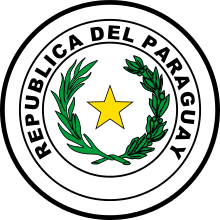Crime in Paraguay

Crime in Paraguay has increased in recent years with criminals often targeting those thought to be wealthy.[1] Although most crime in Paraguay is nonviolent, there has been an increase in the use of weapons and there have been incidents where extreme violence has been used.[1]
Crime by type
Murder
In 2012, Paraguay had a murder rate of 9.7 per 100,000 population.[2] There were a total of 649 murders in Paraguay in 2012.[2]
Corruption
Observers maintain that corruption in Paraguay remains a major impediment to the emergence of stronger democratic institutions and sustainable economic development.[3]
Illegal drug trade
The illegal drug trade in Paraguay is significant in both production of cannabis and trans-shipment of cocaine.[2] In 2011 the United Nations reported that it was the largest cannabis producer in South America, accounting for 15 per cent of world cannabis production.[4] It was also responsible for 30-40 tons of cocaine trans-shipment annually.[4]
Domestic violence
On average one woman is murdered in Paraguay every 10 days.[5] Although Paraguay has taken several measures to deal with this problem, including creating special police units for domestic violence victims,[6][7] lack of adequate laws, as well as conservative attitudes within a male dominated society hinder progress.
Robbery
Armed robbery, carjackings, car theft, and home invasions are a problem in both urban and rural areas.[1] Street crime including pick pocketing and mugging is prevalent in cities.[1]
As of 2008, the number of pick pocketing incidents and armed assaults was increasing on public buses and in the downtown area of Asunción.[1] There have been incidents of pilferage from checked baggage at both airports and bus terminals.[1] Unauthorized ticket vendors also reportedly operate at the Asuncion bus terminal, badgering travelers into buying tickets for substandard or non-existent services.[1]
References
- 1 2 3 4 5 6 7 Paraguay: Country Specific Information. U.S. Department of State (September 15, 2008).
 This article incorporates text from this source, which is in the public domain.
This article incorporates text from this source, which is in the public domain. - 1 2 3 Global Study on Homicide. United Nations Office on Drugs and Crime, 2013.
- ↑ "Paraguay: Background and U.S. Relations" (RL34180). Olhero, Nelson & Mark P. Sullivan. Congressional Research Service (September 20, 2007).
 This article incorporates text from this source, which is in the public domain.
This article incorporates text from this source, which is in the public domain. - 1 2 United Nations Office on Drugs and Crime, 9 November 2011, UNODC and Paraguay launch $10 million programme to combat drugs and crime
- ↑ http://www.ipsnews.net/2010/03/paraguay-new-police-units-for-domestic-violence-victims/
- ↑ http://www.ipsnews.net/2010/03/paraguay-new-police-units-for-domestic-violence-victims/
- ↑ http://www2.ohchr.org/english/bodies/cedaw/docs/co/CEDAW-C-PRY-CO-6.pdf
| |||||||||||||||||||||||||||||||||||||||||
| |||||||||||||||||||||

